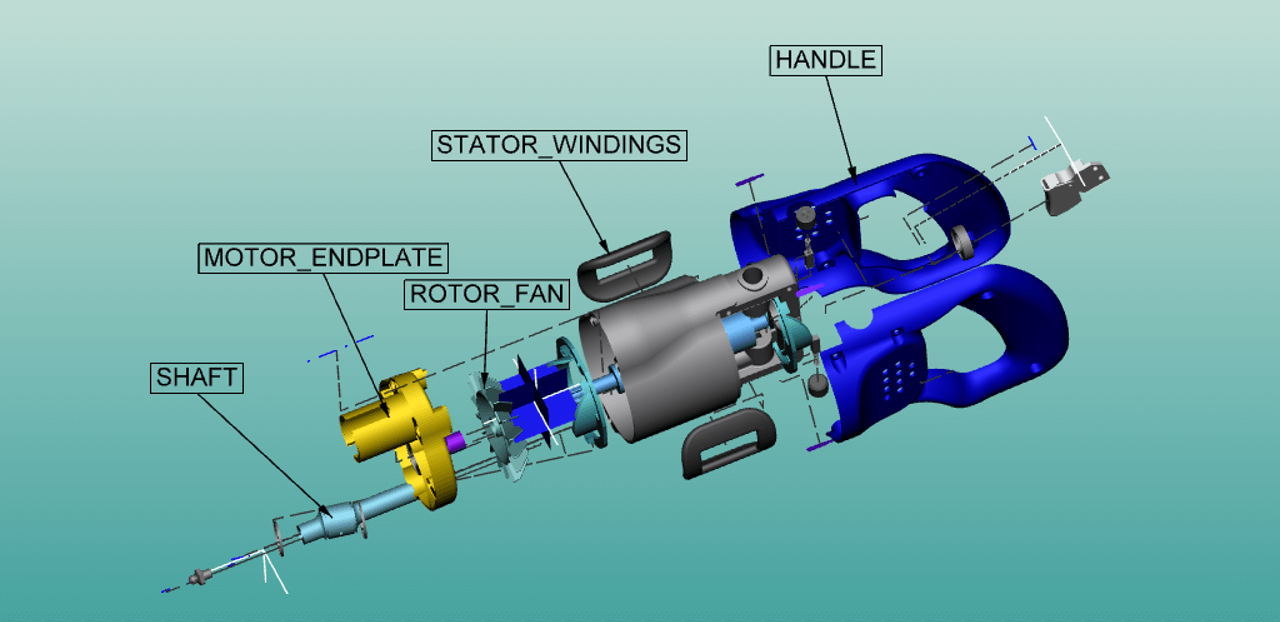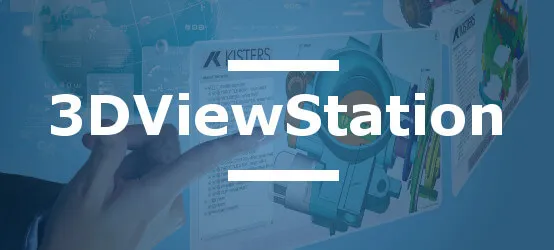Technical visualization and particularly the creation of exploded views are essential elements in the documentation of complex assemblies. These representations transform 3D models into clear visual instructions facilitating the understanding, assembly, and maintenance of industrial products. Faced with the constant evolution of technical documentation requirements, professionals are seeking solutions to generate these views quickly and efficiently, while preserving accuracy and quality of representations.
In an industrial context where assemblies are becoming increasingly complex and where interoperability between CAD systems represents a major challenge, having efficient tools to create exploded views becomes strategic. How can we optimize this process while controlling costs and timeframes associated with technical documentation?
Table of contents
- Current challenges in technical documentation
- Methods and techniques for creating exploded views
- Advantages of modern exploded views
- 3DViewStation: Advanced solution for exploded views
- Advanced transformation features
- Exceptional performance with large assemblies
- Practical applications of exploded views
- Concrete advantages of using 3DViewStation
- Conclusion
Current challenges in technical documentation
Technical documentation of industrial assemblies faces several major challenges that directly impact productivity and the quality of deliverables. These issues have intensified with the evolution of manufactured products and the digitalization of industrial processes.
The increasing complexity of modern industrial assemblies constitutes the first challenge. Products now incorporate more components, often miniaturized and assembled in confined spaces. This densification makes traditional visual representation insufficient for effectively communicating spatial relationships between parts.
Interoperability between CAD systems represents another significant obstacle. In a typical industrial environment, several design software coexist, generating different data formats. This heterogeneity complicates the creation of consistent technical documentation, particularly for exploded views that require a precise understanding of assembly structures.
Traditional documentation creation methods generate high costs and considerable delays. Manual generation of exploded views mobilizes qualified technical resources for extended periods, directly impacting budgets and development cycles.
Finally, the need to produce accurate documentation for training and maintenance intensifies with product complexity. Technical teams and customers demand clear visual instructions to facilitate assembly, maintenance, and repair operations.
Methods and techniques for creating exploded views
Several methodological approaches exist for generating exploded views of CAD assemblies, each presenting its advantages and limitations. Understanding these different techniques allows professionals to select the approach best suited to their specific needs.
Manual vs automated approaches
Techniques for creating exploded views primarily fall into two categories:
- Manual approaches: They offer precise control over the positioning of each component but require considerable time and in-depth technical expertise.
- Automated methods: Based on algorithms, they allow rapid generation of complete exploded views but may lack refinement in certain complex configurations.
Techniques based on assembly hierarchy
CAD assemblies generally have a hierarchical structure (assembly tree) that defines relationships between components. Modern techniques exploit this organization to:
- Identify logical subassemblies within a main assembly
- Automatically determine optimal explosion directions
- Maintain relative positioning relationships between parts of the same subassembly
- Apply differentiated explosion levels according to hierarchical depth
Transformation customization options
The flexibility of exploded view creation tools relies on several customization options:
- Control of explosion distance between components
- Definition of transformation rules for specific groups
- Adjustment of displacement axes to optimize readability
- Application of differentiated scale factors according to visualization needs
Axial and radial displacement strategies
Two main approaches govern component displacement when creating exploded views:
| Displacement type | Characteristics | Ideal applications |
|---|---|---|
| Axial displacement | Translation along a single axis (X, Y, or Z) | Linear assemblies, component stacks |
| Radial displacement | Expansion from a central point of the assembly | Circular assemblies, concentric components |
| Hybrid method | Combination of axial and radial approaches | Complex assemblies with varied subassemblies |
Advantages of modern exploded views
Modern exploded views generated using specialized tools bring considerable added value to industrial processes. Their impact extends well beyond simple visual representation to fundamentally transform technical communication.
Improved understanding of complex assemblies
Exploded views allow distinct visualization of each component in an assembly and their spatial relationships. This visual clarification facilitates immediate understanding of complex structures, even for people unfamiliar with the assembly in question. Assembly relationships become evident, and assembly paths appear naturally.
Reduction of assembly and maintenance errors
By clearly illustrating the sequence and position of each component, exploded views significantly reduce the risk of errors during assembly and maintenance operations. This error reduction translates into:
- A reduction in assembly times of up to 30%
- Reduced returns and rework related to incorrect assembly
- Improved product reliability after maintenance
- Decreased costs associated with operational errors
Optimization of operator training
Exploded views constitute particularly effective educational supports for technical training. They allow:
- Accelerated visual learning of assembly procedures
- Improved memorization of operational sequences
- Reduced time required for skill acquisition
- Standardization of work methods across different sites
Product enhancement in commercial documentation
Beyond their technical utility, exploded views bring an aesthetic and professional dimension to commercial documentation. They contribute to:
- Highlighting the complexity and technical sophistication of products
- Reinforcing the perception of quality and expertise
- Facilitating customer understanding of technical characteristics
- Differentiating the commercial offering through superior visual communication
3DViewStation: Advanced solution for exploded views
3DViewStation represents a complete visualization and CAD analysis solution specifically designed to meet the requirements of modern industrial environments. This software is distinguished by five fundamental attributes that define its value proposition:
- EASY: Intuitive user interface requiring no training
- FAST: Loading of large assemblies within seconds
- COMPLETE: All-in-one solution for all use cases (3D, 2D, mobile, analysis)
- INTELLIGENT: Advanced analysis and manipulation features
- ZERO: Web integration with no installation, administration or system footprint
Multi-format compatibility for maximum interoperability
3DViewStation offers true multi-CAD capability, allowing visualization and manipulation of data from various design systems. This extended compatibility includes major formats such as CATIA V5, Pro-Engineer Creo, NX, SolidWorks and many others.
Reliable and fast importers ensure data integrity when opening models, a crucial aspect for accurate exploded view creation. Users can thus generate exploded views without requiring knowledge of the original software used to create the model.
Methods for creating exploded views
3DViewStation offers two complementary approaches for creating exploded views, adapted to different needs and user expertise levels:
Free Drag manual method
This approach offers precise control over each component:
- Direct manipulation of objects with the Free Drag tool
- Use of movement, rotation, and mirror functions via intuitive handles
- Option to create displacement materialization lines to illustrate component movement
- Granular control allowing fine adjustments for detailed documentation
EXPLODE automatic method
For fast and efficient creation:
- Activation of automatic mode with a simple click on EXPLODE
- Adjustment of the explosion via a dynamic slider
- Configurable parameters to restrict transformations on a specific axis
- Explosion options based on assembly hierarchy
- Immediate generation of a complete and coherent exploded view
Advanced transformation features
Beyond basic explosion capabilities, 3DViewStation offers a complete set of transformation tools allowing precise and professional technical documentation:
Intelligent component movement
- Axial translation (X, Y, Z) with precise numerical control
- Free movement with collision detection
- Component grouping for simultaneous movement
- Automatic alignment according to assembly constraints
Pivoting and rotation
- Rotation around predefined or custom axes
- Definition of specific pivot points
- Rotation by precise increments for fine adjustments
- Preservation of hierarchical relationships during rotation
Mirror function
- Creation of mirror views to illustrate symmetries
- Mirroring according to standard or custom planes
- Combination with other transformations for complex visualizations
- Support for documenting symmetrical parts
View management and saving
A particularly powerful aspect of 3DViewStation lies in its ability to save transformations as views:
- Saving transformation states for future reference
- Creating view sequences to illustrate assembly/disassembly steps
- Generating animations based on transitions between views
- Exporting views for integration into technical documentation
Exceptional performance with large assemblies
Performance constitutes a major differentiator of 3DViewStation compared to competing solutions. This technical superiority is particularly evident when handling large assemblies commonly encountered in modern industry.
Objective performance indicators demonstrate the software's exceptional ability to process complex models:
- Loading of 5 GB CATIA models or assemblies of 20,000 parts in 1 second
- Instant interaction even with complex assemblies
- Support for multi-CAD DMU (Digital Mock-Up) visualization
- Modern user interface based on DirectX optimizing graphic performance
This execution speed radically transforms the user experience, allowing engineers and documentation technicians to focus on creative aspects rather than waiting for models to load or manipulate. In an industrial context where time represents a critical resource, this performance directly translates into an improvement in overall productivity.
Practical applications of exploded views
Exploded views generated with 3DViewStation offer significant added value in numerous industrial scenarios:
Enhanced technical documentation
Creating technical documentation constitutes the primary application of exploded views. This enhanced documentation includes:
- Visually explicit assembly manuals
- Clear illustration of assembly and disassembly sequences
- Preventive and corrective maintenance documentation
- Interactive parts catalogs with contextual visualization
Training and skills transfer
Exploded views constitute particularly effective educational supports for technical training. They allow:
- Visual support for training assembly operators
- Simulation of maintenance procedures
- Reduction of the learning curve for new technicians
- Standardization of assembly methods across production sites
Optimized technical communication
Beyond formal documentation, exploded views facilitate technical communication at all levels:
- Clear visual presentation of engineering concepts to non-technical stakeholders
- Support for resolving assembly problems
- Facilitation of collaboration between engineering and production teams
- Improved communication with suppliers and subcontractors
Concrete advantages of using 3DViewStation
The adoption of 3DViewStation for creating exploded views generates measurable benefits for industrial organizations:
Operational benefits
| Aspect | Concrete benefits |
|---|---|
| Speed | Reduction of up to 80% in time required to create complex exploded views |
| Accessibility | Intuitive interface allowing use by all departments (engineering, documentation, support) |
| Precision | Faithful representation of spatial relationships between components |
| Flexibility | Adaptation to existing workflows thanks to integration APIs |
| Productivity | Automation of repetitive documentation creation tasks |
Impact on documentation quality
Beyond productivity gains, using 3DViewStation significantly improves the overall quality of technical documentation:
- Standardization of technical representations across the company
- Reduction of interpretation errors thanks to clear visualizations
- Consistent documentation regardless of the original CAD systems
- Simplified updating when design changes occur
Integration into the technical ecosystem
3DViewStation integrates perfectly into existing technical infrastructure thanks to:
- Rich APIs for integration into PDM/PLM systems
- Role-based clients for PLM systems
- Hyperlinking capabilities for contextual navigation
- Flexible deployment options (Desktop, ActiveX, Web, VR)
Conclusion
Creating exploded views of CAD assemblies represents a fundamental pillar of modern technical documentation. Facing growing challenges of assembly complexity and multi-CAD interoperability, specialized solutions like 3DViewStation provide a technological response adapted to contemporary industrial needs.
Through its unique combination of ease of use, performance with large assemblies, and advanced transformation features, 3DViewStation establishes itself as a reference solution for organizations wishing to optimize their technical documentation processes. The multiple approaches to creating exploded views – whether manual for precise control or automatic for maximum efficiency – allow adaptation to all industrial use cases.
By transforming complex CAD assemblies into clear and instructive visualizations, this solution directly contributes to improving technical communication, reducing assembly errors, and optimizing training processes. Its harmonious integration into existing technical ecosystems makes it a strategic investment for industrial companies concerned with operational and documentary excellence.



